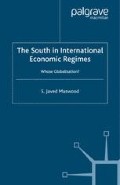Abstract
Most policy makers and trade economists acknowledge that multilateralism is a superior alternative to bilateral and regional trade agreements for all countries. Regional and bilateral agreements are best understood as preferential trade agreements (PTAs) because they assign to contracting parties certain preferences that are not available to other states. At the end of 2004, the World Trade Organization (WTO) had been notified of around 300 PTAs that had been negotiated among member countries. With the growing popularity of preferential trade agreements, a recent report on the future of the WTO lamented the reality that the most favored nation (MFN) clause, a central pillar of the WTO, was in danger of becoming Least Favored Nation clause.1 WTO and the General Agreement on Tariffs and Trade (GATT) have accepted the inevitability of some preferential trade agreements as long as they resulted in genuine liberalization of trade among participant countries and provided such agreements did not result in higher trade barriers against external countries (Article 24). Still this was a reluctant acceptance and or the many PTAs that have been signed, few are actually consistent with multilateral trade rules, but as Jeffrey Schott points out none were actually ruled by the GATT or WTO as being inconsistent.2
Access this chapter
Tax calculation will be finalised at checkout
Purchases are for personal use only
Preview
Unable to display preview. Download preview PDF.
Notes
Sutherland, P., Jagdish Bhagwati et al. The Future of the WTO: Addressing Institutional Challenges in the New Millennium (Geneva: World Trade Organization, 2004). chapter 2.
Schott, J.J., “Free Trade Agreements: Boon or Bane of the World Trading System?,” in Jeffrey J. Schott (ed.), Free Trade Agreements: US Strategies and Priorities (Washington, DC: Institute for International Economics, 2004), p. 4.
Weintraub, S., “Lessons from the Chile and Singapore Free Trade Agreements,” in Jeffrey J. Schott (ed.), Free Trade Agreements: US Strategies and Priorities (Washington, DC: Institute for International Economics, 2004), p. 83.
Schott, J.J., “Free Trade Agreements: Boon or Bane of the World Trading System?,” in Jeffrey J. Schott (ed.), Free Trade Agreements: US Strategies and Priorities (Washington, DC: Institute for International Economics, 2004), p. 8.
Rajan, Ramkishen S., Rahul Sen and Reza Siregar Singapore and Free Trade Agreements: Economic Relations with Japan and the United States (Singapore: Institute of Southeast Asian Studies, 2001), p. 8.
Bouzas, R., “Regional Trade Arrangements: Lessons from Past Experiences,” in Mendoza, M.R., Patrick Low and Barbara Kotschwar (eds), Trade Rules in the Making: Challenges in Regional and Multilateral Negotiations (Washington, DC: Brookings Institution Press, 1999), p. 182.
Gionea, J. International Trade and Investment: An Asia-Pacific Perspective (Sydney, Australia: McGraw-Hill, 2003), p. 177.
See the two studies by Andrew Rose Do We Really Know that the WTO Increases Trade?, NBER Working Paper No. 9273, and Do WTO Members Have a More Liberal Trade Policy?, NBER Working Paper No. 9347, 2003.
Sewell, John W. and I. William Zartman, “Global Negotiations: Path to the Future or Dead-End Street?,” in Jagdish N. Bhagwati and John Gerard Ruggie (eds), Power, Passions, and Purpose: Prospects for North-South Negotiations (Cambridge, MA: The MIT Press, 1984), p. 121.
See, for example, Miles Kahler, “Multilateralism with Small and Large Numbers,” in Ruggie, John G. (ed.), Multilateralism Matters: The Theory and Praxis of an Institutional Form (New York: Columbia University Press, 1993).
Kahler, M., “Multilateralism with Small and Large Numbers,” in Ruggie, John G. (ed.), Multilateralism Matters: The Theory and Praxis of an Institutional Form (New York: Columbia University Press, 1993), p. 302.
Author information
Authors and Affiliations
Copyright information
© 2006 S. Javed Maswood
About this chapter
Cite this chapter
Maswood, S.J. (2006). Bilateralism in a Multilateral World. In: The South in International Economic Regimes. International Political Economy Series. Palgrave Macmillan, London. https://doi.org/10.1057/9780230626270_7
Download citation
DOI: https://doi.org/10.1057/9780230626270_7
Publisher Name: Palgrave Macmillan, London
Print ISBN: 978-1-349-54616-9
Online ISBN: 978-0-230-62627-0
eBook Packages: Palgrave Political & Intern. Studies CollectionPolitical Science and International Studies (R0)

